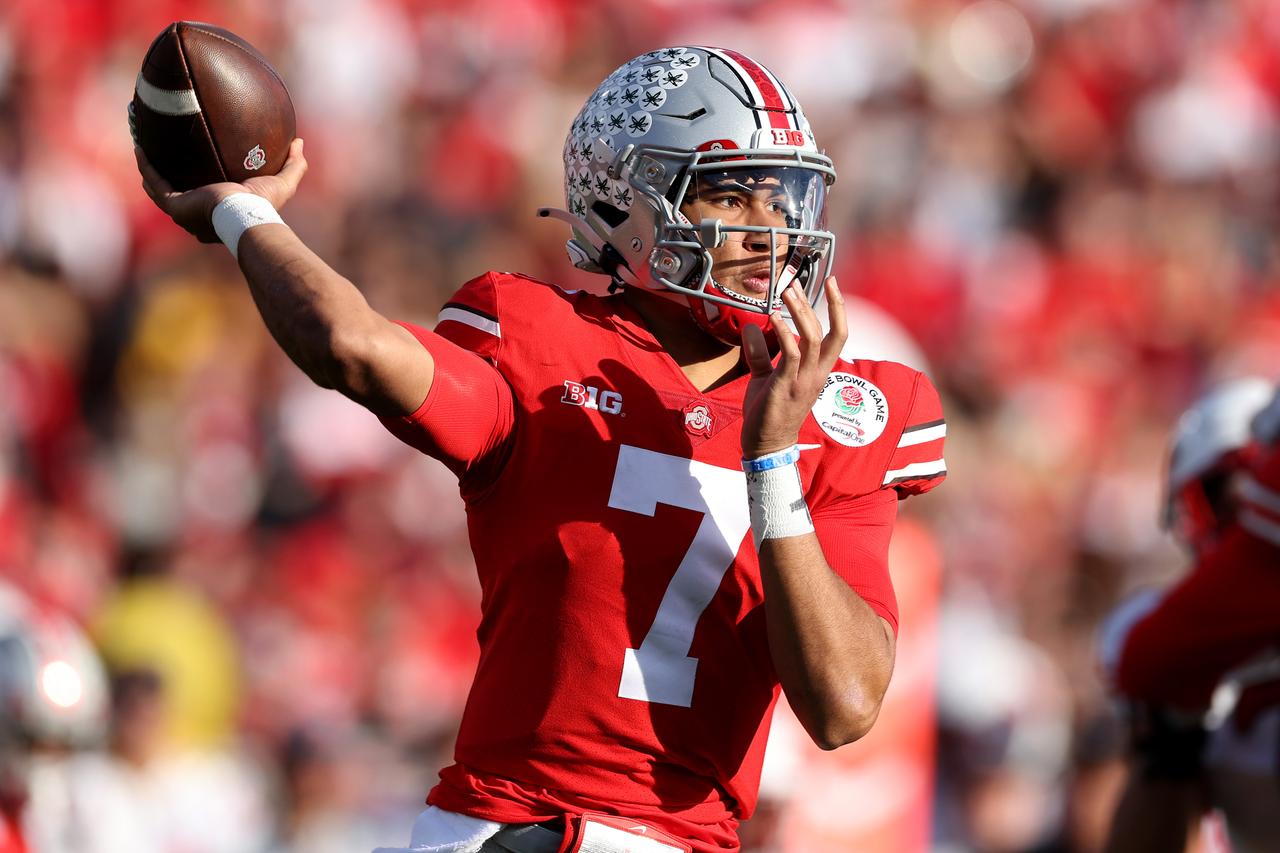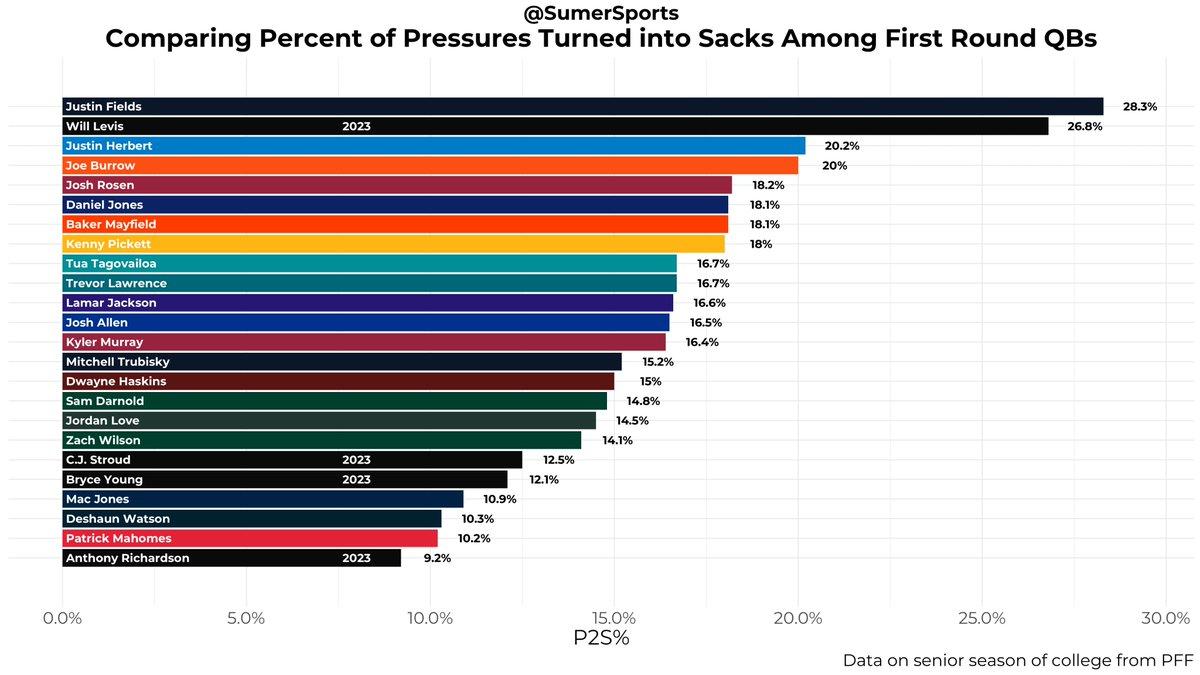2023 NFL Draft QB Rankings, Grades, and Profiles

2023 NFL Draft Quarterback rankings, grades, profiles, analytics, and film notes for the consensus top-five QB prospects -- C.J. Stroud, Bryce Young, Anthony Richardson, Hendon Hooker, and Will Levis. Hayden Winks drops his early looks at each prospect, with more notes coming as we get closer to the 2023 NFL Draft.
If you agree or disagree with these takes, you should go to Underdog Fantasy and play in our $1 MILLION fantasy football tournament that features the entire 2023 rookie class. That contest will close well before the draft begins, so go to the lobby now. Promo code 'underblog' gets you a $100 deposit match bonus. You'll love it.
1. C.J. Stroud (Draft Grade: 1st Overall)
At 6’3” and 215 pounds, Stroud looks like an NFL quarterback and comes equipped with B+ arm strength that doesn’t require a big build up to deliver speed. He has starting-level accuracy to the intermediate part of the field, with a 65% on-target rate on outside throws with 10+ air yards per Sports Info Solutions (SIS). The Buckeyes offense utilized a lot of bootleg, which showed off his throw on the run ability, but his in-pocket stats are insane. He had +0.46 and +0.33 EPA per play on non-play action and non-RPO dropbacks, both clearly the best in college football. His 3.8% sack rate on those dropbacks are a major positive, too. He led college football in QBR in his first Ohio State season and was third in 2022, which puts him in the 92nd percentile among drafted QBs since 2005.
Ultimately, Stroud is a strong in-pocket prospect, who keeps his eyes up against pressure instead of scrambling. He only scrambled 31 times in 25 college games but did do it six times for 66 yards against an elite Georgia defense in the College Football Playoff per SIS. If that athleticism comes out in the NFL, his ceiling is at a Pro Bowl level at least. I compare him to post-ankle surgery Dak Prescott with more development.
2. Anthony Richardson (Early Round 1)
Similar to Trey Lance, Richardson has a boom-bust profile featuring elite athleticism but a suspect passing profile due to a lack of reps. The 4-star recruit and early declare stands at 6’4” and 244 pounds with a big lower half like Justin Fields. He has Tier 1b speed, featuring 54.5 rushing yards per game with 9 rushing scores. Richardson will be used on zone read and as a scrambler, but his short-yardage package should be excellent. He had an elite 73% success rate on runs with 3-or-fewer yards to go, a profile that’s becoming more and more valuable (see: Jalen Hurts). In the pocket, his arm is very live. He can throw it 60 yards on the run, no problem, but he’s still learning touch on short throws.
Ultimately, Richardson was 86th out of 123 qualifiers in passing EPA in 2022, was 111th in on-target rate (73%) on throws under nine air yards, and is in the 22nd percentile in Total EPA among drafted QBs since 2005. He’d be an outlier NFL success based on these key metrics and his development will take some time, but the athleticism and arm strength are highly intriguing. He really needs to improve his throwing touch. Often overlooked, Richardon’s secret trait is avoiding sacks and maneuvering the pocket. His -7.1 EPA lost on sacks is in the 89th percentile among drafted QBs and is a good starting point while he runs around early in his NFL career. I compare him to an unpolished Josh Allen and worthy of a dice roll at the NFL’s most important position. An aggressive team can maximize his athleticism by setting up shorter 4th-down conversions and running heavily in the red zone, just like the Eagles did with Jalen Hurts.
3. Bryce Young (Early Round 1)
A consensus 5-star recruit and highly productive Heisman candidate at Alabama, Young would be a decent first overall pick if not for his complete outlier size (5’10” and 195 pounds). Unlike Kyler Murray, Young doesn’t have elite fast-twitch as a scrambler or downfield thrower. He can stand too upright in the pocket (think tippy toes in a class picture), sacrificing some velocity on outside throws causing some balls to miss short. I think he’d be a 91 MPH pitcher, as evidenced by his middling 53% on-target rate on outside throws with 10+ air yards per SIS. The Crimson Tide offense was almost all shotgun, featuring some RPOs, but only 25% of his dropbacks were off play action. This was a pro-level offense and he had a strong 8.2 yards per attempt on those non-play action passes. Young handled pressure very well (9.3 YPA per PFF) and has very strong poise in the pocket. That’s his best trait. By far. He looks to throw at all costs, rarely scrambling. When he does run, Young has adequate speed but don’t expect a massive short-yardage package with him.
Ultimately, to succeed in the NFL, Young will have to win inside the pocket in ways that aren’t normal. He’ll have to make floaters and step back threes in traffic, all while surviving big hits. The good news is he did so repeatedly against the SEC; His sophomore season EPA puts him in the 92nd percentile among drafted QBs since 2005. There aren’t many comparable players, but he is directionally on a Tua path based on his pass-first, in-pocket success despite below-average size and mediocre arm strength. Young reads the field better and is less RPO reliant but isn’t quite as accurate as Tua.
4. Hendon Hooker (Late Round 1)
This is one of the weirder profiles I can remember. Hooker looks (6’3”/221) and produced (58-to-5 TD-to-INT ratio in final two years) like an NFL starter against SEC competition but rarely gets first round buzz because he’s coming off a torn ACL, will be well into his age-25 season as a rookie, and played in a deep choice route and spread offense. “How much does his 83rd percentile EPA among drafted QBs translate to the NFL?” is the question. While there were easy throws in a schemed-up offense, Hooker did have a solid +0.21 EPA per dropback on non-play action and non-RPO passes, while only having a 1.1% turnover-worthy play rate on all dropbacks per PFF. He’s a polished, experienced in-pocket passer with middling creativity. Only five completions came when moved off of his dropback spot per PFF, partially because he’s very leggy in his movements (con) but also because he has a good pre-snap picture (pro). There are lots of full field throws on his tape, too, many of which come on outside throws. His accuracy is fine, with a 57% on-target rate on outside throws with 10+ air yards (42nd out of 131 college QBs). His arm strength doesn’t move the needle either way, which probably keeps his highlight tape from going viral.
Ultimately, Hooker would be a guaranteed first-rounder if he was younger and healthier, despite his robotic playing style. He’s a twitchier Teddy Bridgewater, who averaged 40 rushing yards per game over his final three years. He can be utilized in short-yardage and can be an okay scrambler. NFL teams will know if his skill set and experience will translate to a more NFL-like offense once they get him on the white board, but he has the poise and had enough full-field reads in college to project as a capable backup, if not a lower-ceiling starter.
5. Will Levis (Late Round 2)
The most debated QB prospect in the class, Levis (6’3”/230) will be a nearly 24-year-old rookie coming off a 9th percentile EPA final season among drafted QBs. His -0.09 EPA per play on non-play action and non-RPO dropbacks is highly concerning and is often correlated with spotty results against pressure. He ranked 116th out of 123 college QBs in EPA lost to sacks last year, and only had a 15-to-8 TD-to-INT ratio when kept clean per PFF. His accuracy underneath needs work and while he has truly elite arm strength (his best trait), Levis only had a 47% on-target rate on outside throws with 10+ air yards (103rd out of 131 college QBs). His highlight tape is littered with big throws that many starting NFL QBs can’t complete physically, but for a fifth-year Power 5 senior, his field processing and footwork are poor and his eyes drop far too often. The good news is that Levis can run like a mad man. He will be a red zone and short-yardage threat on the ground, plus scrambles at a strong level, oftentimes ending runs with a hurdle or truck stick.
To succeed in the NFL, Levis will need to survive with his athleticism early while he hopefully develops better in-pocket feel, pressure recognition, and overall accuracy. Optimists can point to his physical traits and 59th percentile EPA season in 2021 with better supporting talent. Pessimists will point at the rest. I compare him to a faster Drew Lock or cover band Josh Allen. Oh yeah, he also puts mayo in his coffee.

Winks QB Prospect Rankings Since 2020
Link to my 2020 class, 2021 class, and 2022 class (Part I and II).
Joe Burrow (First Overall Grade)
Trevor Lawrence (First Overall Grade)
Justin Fields (First Overall Grade)
C.J. Stroud (First Overall Grade)
Anthony Richardson (Early First Round Grade)
Tua Tagovailoa (Early First Round Grade)
Justin Herbert (Early First Round Grade)
Mac Jones (Early First Round Grade)
Bryce Young (Early First Round Grade)
Zach Wilson (Early First Round Grade)
Trey Lance (Early First Round Grade)
Jalen Hurts (Mid First Round Grade)
Kenny Pickett (Late First Round Grade)
Hendon Hooker (Late First Round Grade)
Jordan Love (Early Second Round Grade)
Will Levis (Late Second Round Grade)
Malik Willis (Late Second Round Grade)
Desmond Ridder (Late Second Round Grade)
Matt Corral (Late Second Round Grade)